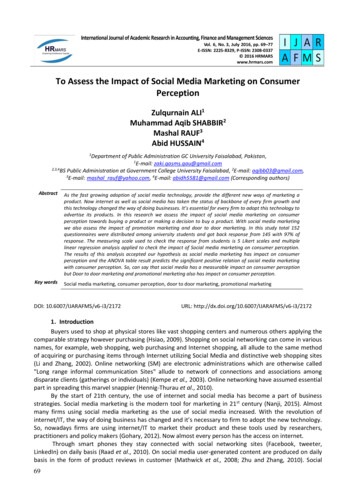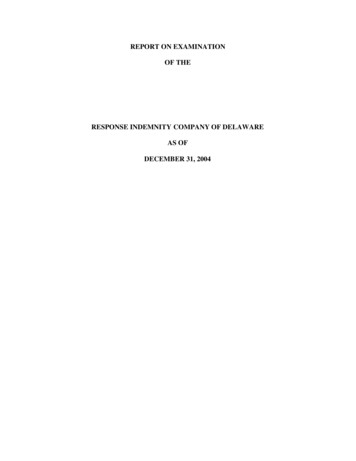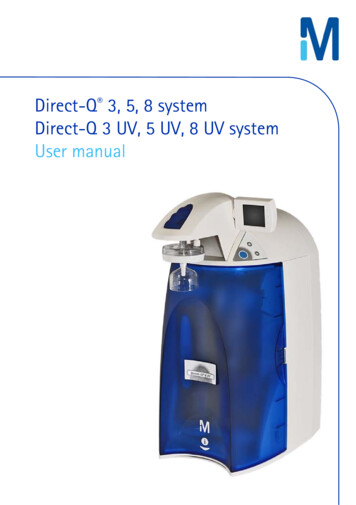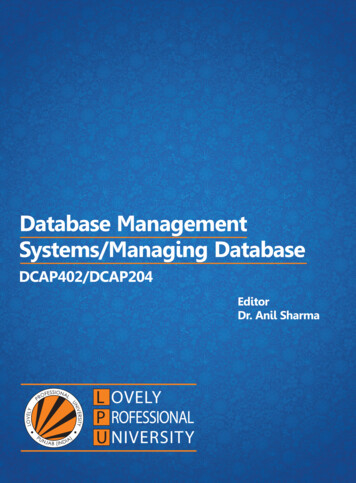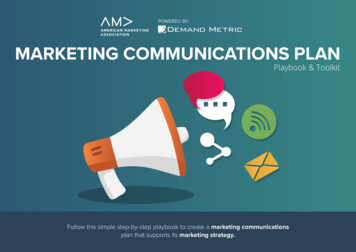
Transcription
Database and DirectResponse MarketingChapter 1111-1
Chapter Objectives1.2.3.4.How can a marketing team match a databaseprogram with an IMC program?What is meant by “database-driven marketingcommunications?”Name the ways a company’s database can be usedto create permission marketing, frequencymarketing, and customer relationship managementprograms.Which direct response marketing programs aremost effective and least effective?
Overview of Integrating MarketingCommunicationsREGULATIONS & ETHICSIntegration ToolsEVALUATIONDATABASE & DIRECT RESPONSESALES PROMOTIONSPromotional ToolsPUBLIC RELATIONS ANDSPONSORSHIPSTRADITIONAL MEDIAE-ACTIVE MARKETINGIMC Media ToolsALTERNATIVE CHANNELSADVERTISING MANAGEMENTAdvertising ToolsADVERTISING DESIGN THEORY AND APPEALSADVERTISING DESIGN MESSAGES AND FRAMEWORKSCORPORATE IMAGE BRAND MANAGEMENTIMC FoundationBUYERS BEHAVIORSPROMOTIONS OPPORTUNITY ANALYSIS
Database Marketing The secret to developing LoyaltyRecognitionRelationshipsReward ProgramsDatabase marketing is a form ofdirect marketing using databases of customers or potentialcustomers to generate personalized communications in order topromote a product or service for marketing purposes. The method ofcommunication can be any addressable medium, as indirect marketing.
Database Marketing Collecting and utilizingcustomer data for thepurposes of enhancinginteractions withcustomers anddeveloping customerloyalty. Successful databasemarketing involvesidentifying customersand buildingrelationships.
Data Warehouse Holds all customer data Customer information Purchasing patterns Purchase history Preferences
Good Data Warehouse Should include: E-mail and Internet Data Purchase and CommunicationHistories Personal Preference Profiles Customer Information Companies Geocoding
The Marketing Data Warehouse Customer names and addressesE-mail addressesRecord of visits to the firm’s Web siteHistory of every purchase transactionHistory of customer interactionsCustomer survey resultsPreferences and profiles supplied by thecustomerResponse history from marketing campaignsAppended dataDatabase coding through customer analysesAppended demographic and psychographicdata from other sources
Tasks in Database Marketing1.2.3.4.5.Building a data warehouseDatabase coding and analysisData miningData-driven marketing communicationsData-driven marketing programs
1. Building a Data Warehouse A data warehouse holds all customer data. Data warehouses store current and historicaldata and are used for creating trendingreports The data stored in the warehouse is uploadedfrom the operational systems (such asmarketing, sales, etc., shown in the figure tothe right).
2. Database Coding & Analysis The goal of this process is to be able topersonalize marketing messages tocustomers based on the data collected.
Lifetime Value A figure that represents the profit revenueof a customer throughout the lifetime of arelationship.
Lifetime Value Analysis Some companies calculate the LTV of anindividual customer. Others of a target segment. Where would it make sense to calculate theLTV of an individual customer. (high endpurchases) Key figures in calculating the LTV of aconsumer or set of consumer are revenues,costs, retention rates, visits or purchasesper time period, normally 1 year.
RFM Analysis Recency The date of the last purchase Frequency The number of purchases in a giventime period Normally one year Monetary The cumulative monetaryexpenditures made during that timeperiod
3. Data Mining Data mining normally involvesone of two approaches: Building profiles of customergroups. Preparing models that predictfuture purchase behaviors basedon past purchases.
4. Data Driven CommunicationsRevolutionized data driven messaging: It is the cheapest form of communication. It is available 24/7. Metric analysis reveals that the customerread the message, time it was read, and howmuch time was spent reading it. Customers are able to access additionalinformation whenever they want. It can build a bond with customers.
5. Data-Driven Marketing Programs1. Permission marketing2. Frequency/loyaltyprograms3. Customer relationshipmanagement
Permission Marketing The company only sends promotionalinformation to customers who give permission Advantages: Response rates are often higher Marketing costs are reduced, because people who are notinterested in the products do not receive marketingmaterials Customers can be reached by telephone, mail, or e-mailPermission marketing is the privilege (not the right) of delivering anticipated, personal andrelevant messages to people who actually want to get them. It recognizes the new power ofthe best consumers to ignore marketing. It realizes that treating people with respect is thebest way to earn their attention. – Steve Godin
Reason Customers Opt-in: Sweepstakes or chance to win (41%) Found site randomly (37%) E-mail required to access content (38%) Already a customer (40%) Friends recommended (24%)Stay Loyal Interesting content (36%) Account status updates (35%) Price Bargains (34%) Entertainment (27%)
Successful Permission Marketing Ensure recipients have granted permissionMake e-mails/social media relevantCustomize programTrack member activityEmpowermentPermission is like dating. You don't start by asking for the sale at firstimpression. You earn the right, over time, bit by bit. - Steve Godin
Frequency Programs A frequency program is an incentive plandesigned to cause customers to make repeatpurchases. Companies develop frequency programs for twoprimary reasons:1.To develop loyalty in customers.2.To match or preempt the competition.
Customer Relationship Management(CRM) Programs designed to build long termloyalty and bonds with customers. Include modifying products to meetindividual needs. Built on two primary metrics Lifetime value Share of customer
Social Media CRM
Direct Response Marketing Designed to generate an immediate response fromconsumers, where each consumer response (andpurchase) can be measured, and attributed toindividual advertisements. There are no intermediaries such as retailersbetween the buyer and seller, and therefore thebuyer must contact the seller directly to purchaseproducts or services. Direct-response marketing is delivered through awide variety of media
Direct Response Marketing Direct marketing programs aredesigned to develop closerrelationships with customersthrough direct contact by: Mail Catalogs Telemarketing Mass media Alternative media Internet E-mail
Marketing costs are reduced, because people who are not interested in the products do not receive marketing materials Customers can be reached by telephone, mail, or e-mail Permission marketing is the privilege (not the right) of delivering anticipated, personal and r


